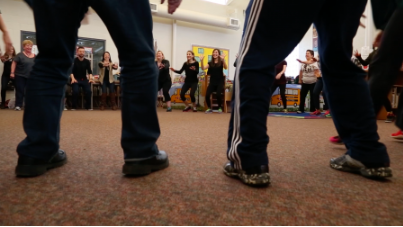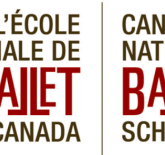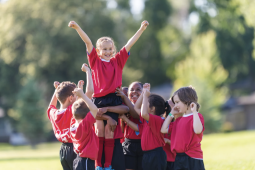Partner Work: Dance Organizations Collaborate for Bigger Impact

Previously published in Volume 83, Issue 2
Patricia Gough is passionate about the arts, especially when it comes to integrating them into the classroom. Canada’s National Ballet School (NBS) agrees, so when Gough reached out to NBS about its Sharing Dance classroom resources, it was the start of a terrific partnership between Gough’s ArtsAround organization and NBS’ Sharing Dance community initiative.
Expression, creativity and collaboration
“At ArtsAround we believe that every child deserves the chance to express themselves through the arts,” says Gough, founder and director of the Hamilton-based organization that provides integrated, teacher-friendly lessons weaving the arts into cross-curricular subjects. “The arts improve learning, confidence, problem solving and social development.”
NBS feels the same way and knows that dance is a unique activity that can collaboration and creativity among children, and can help them express themselves artistically. Involvement in dance can also support holistic health and well-being (e.g., physical, cognitive, social, emotional, spiritual), including the development of physical literacy. This can instill a love of movement and the motivation to be active for life.
“When dance is introduced in a fun and meaningful way, it can have great emotional and physical benefits,” says Ashleigh Powell, artistic faculty and manager of NBS’ Sharing Dance. “We hope that students will continue to dance and seek more artistic and physical activities in their lives, and hopefully throughout their lives."
Free resources and tools for dance
NBS’ Sharing Dance programs provide just the resources that Gough’s teachers and students need. Featuring multifaceted programming supported through free online resources, Sharing Dance offers high-quality, dance activities that can support the development of physical literacy and promote dance appreciation in the classroom and within a range of community settings.
Cross-curricular classroom resources—created by NBS in partnership with Physical and Health Education Canada (PHE Canada) and the Royal Winnipeg Ballet School—use dance as a kinesthetic learning tool to explore other areas of study (e.g., Geography, Science, Language Arts, etc.). Through an online portal powered by Brightspace (nbscc.brightspace.com) these resources are accessible at no cost and include:
- Downloadable PDF lesson plans
- Comprehensive video content
- Downloadable music created specifically for the lessons
- Sample rubrics
Teacher workshops for enriched instruction
“ArtsAround took the different grade workshops and integrated them immediately into the Dance Intro in ArtsAround programming from Grades 4-8,” says Gough. “The teacher workshops offered through Sharing Dance provide numerous dance extensions that support the Ontario curriculum in many ways. ArtsAround lessons are richer for having started down this path and partnering with Sharing Dance!”
Gough reached out to NBS last year and invited the Sharing Dance team to deliver a workshop to the ArtsAround teachers. Powell and her team introduced a variety of activities that educators could try with their classes. While some were quick, 20-minute dance activities, Powell also demonstrated how any curriculum concept can be illuminated through dance,
“Teachers are passionate about offering students opportunities to move,” says Powell. “When you can combine classroom learning with movement, in a way where each child can succeed and build confidence, it’s a win-win.”
Reaching a growing audience of students and educators
Gough has included Sharing Dance lessons in the ArtsAround program for every Grade from 4 to 8, reaching about 9,000 kids. With 37 educators teaching dance in 52 schools, sometimes the whole school is involved in the dance programs.
Gough and the ArtsAround educators are excited about all Sharing Dance resources and opportunities, such as the annual Sharing Dance Day, a multigenerational community dance performance. Each year, NBS artistic staff commission and work with choreographers to create a unique piece of choreography to be performed at nation-wide Sharing Dance Day events in the spring. The annual event, which now engages ArtsAround and tens of thousands of other Canadians, produces freely accessible resources to help people learn the choreography in classrooms and community settings.
“The teachers are super excited about incorporating Sharing Dance workshops and the yearly dance event into their curriculum,” says Gough. “It makes what happens locally so much more connected when it stretches beyond just their classroom or school. Being connected – learning the same choreographed routines on a more global level – elevates dance to a whole new super magical experience! Keep those dances and tutorials coming!"
Encouraging student leadership
“Sharing Dance brings students a connectedness they would never have realized before,” says Gough. She adds that the students look forward to visiting the site online and learning what the next moves will be. “Dance Captains in various grades have made the entire experience student-led and this takes some of the pressures off teachers,” says Gough. “Just get out of their way and let the kids become leaders—they are very willing and capable!” Gough adds that this approach builds a stronger sense of community, highlights natural dance leaders and helps to spread the workload.
In continued partnership with PHE Canada, over the next five years NBS will expand its classroom and community resources to support educators as well as community groups like dance studios, and youth-based community organizations such as Boys and Girls Clubs, YMCA, etc. The following are slated for development:
- More curriculum-focused lesson plans that use dance as a kinesthetic learning tool
- Curricular and co-curricular resources that explore Indigenous Peoples culture through dance as well as highlight and celebrate some Indigenous dance forms – working in consultation with Indigenous dance artists and educators
- Resources that specifically support community programs that work with children and youth
Learn more at www.sharingdance.ca.
Sharing Dance for Children and Youth classroom resources are supported by Shaw Communications. Sharing Dance is made possible with the support of additional national partners Canada’s Royal Winnipeg Ballet School, PHE Canada, the Globe and Mail and Scotiabank; founding donors Joan and Jerry Lozinski; and leading supporters William R. and Shirley Beatty Charitable Fund and LesLois Shaw Foundation.








